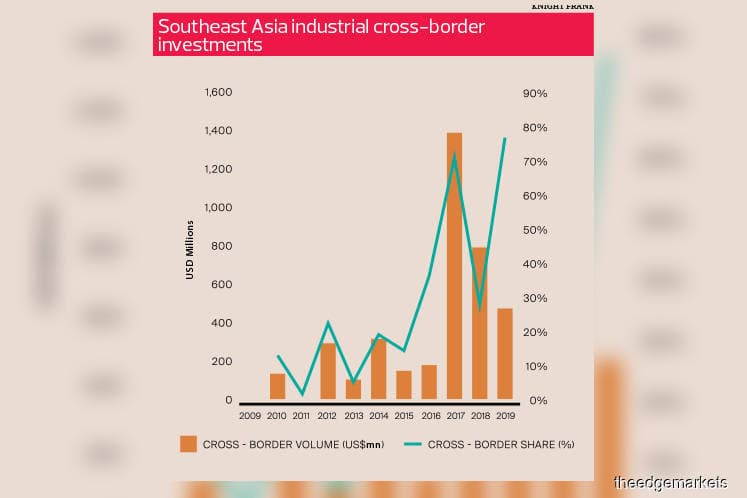
This article first appeared in Personal Wealth, The Edge Malaysia Weekly on May 20, 2019 - May 26, 2019
China has made significant investments in Southeast Asia’s industrial real estate sector under its Belt and Road Initiative (BRI). Interest from Chinese cross-border real estate investors in the region’s industrial sector increased from US$330 million between 2009 and 2015 to a whopping US$1.4 billion in 2017 alone.
This was one of the key statistics in Knight Frank’s report, New Frontiers: Prospects for Real Estate Along the Belt and Road Initiative, released on April 30.
Last year, cross-border industrial real estate investments came in at US$805 million, some 40% higher than the annual average of US$570 million over the last five years. Meanwhile, in the first quarter of this year, cross-border investments exceeded US$480 million and is expected to surpass last year’s investment volume.
Significant amounts of Chinese-linked capital has been chasing opportunities in the region’s transport, real estate and logistics sectors, the report noted. Over the last five years, US$59.25 billion in investment dollars out of China has poured into these three sectors alone. That is nearly 3½ times more than the US$17.1 billion invested in the five years prior to the launch of BRI.
As a result, the region’s industrial and logistics real estate have undergone a revival in recent years. This bodes well for the industrial real estate sector’s outlook over the next three to five years, according to the report.
Malaysia has been a significant beneficiary of Chinese capital, with investments totalling more than US$43.8 billion in the last decade — the highest amount recorded among its Asean peers. According to the Knight Frank Belt and Road Index (BARI), Singapore (first) and Malaysia (ninth) were the only Southeast Asian countries to make the top 10.
Knight Frank’s BARI ranks 66 BRI-related countries by their economic potential, demographic advantages, infrastructure development, institutional effectiveness, market accessibility and resilience to natural disasters.
Knight Frank Malaysia capital markets executive director Allan Sim said in a media statement that following the change of government in May last year, a number of Chinese investments and projects — especially mega infrastructure projects — had been deferred. “However, the attendance of Prime Minister Tun Dr Mahathir Mohamad and Malaysian business delegates at the recently concluded second Belt and Road Initiative Forum for International Cooperation, coupled with his intention to expedite the setting up of a one-stop centre to ease foreign investment-related approvals and bring assurance and confidence to Chinese firms to reconsider investing in Malaysia. Furthermore, with the new agreements for revival of the East Coast Rail Link and Bandar Malaysia, Chinese firms will certainly be looking more seriously at Malaysia again and the industrial segment will benefit the most.
“In particular, we expect more high-tech manufacturers from China to operate in Malaysia, taking advantage of our adequate supply of raw materials, coupled with relatively lower operating costs in running businesses. Moreover, Chinese firms can utilise Malaysia as a manufacturing hub as products manufactured in this country are insulated from tariffs from most major economies, such as the EU, the US and Latin America.”
Johor has been a notable recipient of Chinese real estate investments, with port facilities as well as the industrial and logistics sectors attracting keen interest from investors. Market rents for factories and warehouse space in the state range from 80 sen to RM1.50 per sq ft per month. This is on a par with major industrial zones in Selangor. Appreciation notwithstanding, Malaysia has one of the most attractive warehouse rental rates in the region, ranking just above Cambodia in terms of price (US dollar) per sq m per annum.
Knight Frank’s Johor branch head Debbie Choy said in a recent media statement, “Good air and maritime connectivity in Johor, provided by established infrastructure in the state, namely the Senai International Airport as well as the Johor Port and Port of Tanjung Pelepas have supported the state’s logistics industry.”
“Johor has always been an attractive destination among Chinese investors. In fact, China has been among the largest investors in Iskandar Malaysia since its inception in 2006, especially in the manufacturing sector. Moving forward, Johor is well positioned to capitalise on the continuing strong bilateral relations between China and Malaysia.”
Save by subscribing to us for your print and/or digital copy.
P/S: The Edge is also available on Apple's AppStore and Androids' Google Play.